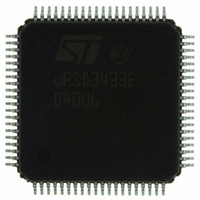UPSD3433EB40U6 STMicroelectronics, UPSD3433EB40U6 Datasheet - Page 100

UPSD3433EB40U6
Manufacturer Part Number
UPSD3433EB40U6
Description
MCU 8BIT 8032 128KB FLASH 80TQFP
Manufacturer
STMicroelectronics
Series
µPSDr
Datasheet
1.UPSD3434EB40T6.pdf
(293 pages)
Specifications of UPSD3433EB40U6
Core Processor
8032
Core Size
8-Bit
Speed
40MHz
Connectivity
I²C, IrDA, SPI, UART/USART, USB
Peripherals
LVD, POR, PWM, WDT
Number Of I /o
46
Program Memory Size
160KB (160K x 8)
Program Memory Type
FLASH
Ram Size
8K x 8
Voltage - Supply (vcc/vdd)
3 V ~ 5.5 V
Data Converters
A/D 8x10b
Oscillator Type
Internal
Operating Temperature
-40°C ~ 85°C
Package / Case
80-TQFP, 80-VQFP
For Use With
497-5518 - EVAL BOARD RFID READER497-5046 - KIT TOOL FOR ST7/UPSD/STR7 MCU
Lead Free Status / RoHS Status
Lead free / RoHS Compliant
Eeprom Size
-
Other names
497-5660
Available stocks
Company
Part Number
Manufacturer
Quantity
Price
Company:
Part Number:
UPSD3433EB40U6
Manufacturer:
STMicroelectronics
Quantity:
10 000
- Current page: 100 of 293
- Download datasheet (5Mb)
Serial UART interfaces
21.1.3
21.1.4
21.1.5
100/293
Mode 2
Mode 2 provides asynchronous, full-duplex communication using a total of 11 bits per data
byte. Data is transmitted through TxD and received through RxD with: a Start Bit (logic '0');
eight data bits (LSB first); a programmable 9th data bit; and a Stop Bit (logic '1'). Upon
Transmit, the 9th data bit (from bit TB8 in SCON) can be assigned the value of '0' or '1.' Or,
for example, the Parity Bit (P, in the PSW) could be moved into TB8. Upon receive, the 9th
data bit goes into RB8 in SCON, while the Stop Bit is ignored. The baud rate is
programmable to either 1/32 or 1/64 of f
Mode 3
Mode 3 is the same as Mode 2 in all respects except the baud rate is variable like it is in
Mode 1.
In all four modes, transmission is initiated by any instruction that uses SBUF as a destination
register. Reception is initiated in Mode 0 by the condition RI = 0 and REN = 1. Reception is
initiated in the other modes by the incoming Start Bit if REN = 1.
Table 46.
Multiprocessor communications
Modes 2 and 3 have a special provision for multiprocessor communications. In these
modes, 9 data bits are received. The 9th one goes into bit RB8, then comes a stop bit. The
port can be programmed such that when the stop bit is received, the UART interrupt will be
activated only if bit RB8 = 1. This feature is enabled by setting bit SM2 in SCON. A way to
use this feature in multi-processor systems is as follows: When the master processor wants
to transmit a block of data to one of several slaves, it first sends out an address byte which
identifies the target slave. An address byte differs from a data byte in that the 9th bit is 1 in
an address byte and 0 in a data byte. With SM2 = 1, no slave will be interrupted by a data
byte. An address byte, however, will interrupt all slaves, so that each slave can examine the
received byte and see if it is being addressed. The addressed slave will clear its SM2 bit and
prepare to receive the data bytes that will be coming. The slaves that were not being
addressed leave their SM2 bits set and go on about their business, ignoring the coming data
bytes.
Mode Synchronization
0
1
2
3
Asynchronous
Asynchronous
Asynchronous
Synchronous
UART operating modes
Bits of SFR,
SM0
0
0
1
1
SCON
SM1
0
1
0
1
OSC
Timer 1 or Timer 2
f
Timer 1 or Timer 2
OSC
Baud Clock
.
/32 or f
Overflow
Overflow
f
OSC
/12
OSC
/64
Data
Bits
8
8
9
9
Start/Stop
1 Start, 1
1 Start, 1
1 Start, 1
None
Stop
Stop
Stop
Bits
See Figure
uPSD34xx
Figure 31
page 105
Figure 33
page 107
Figure 35
page 109
Figure 37
page 110
on
on
on
on
Related parts for UPSD3433EB40U6
Image
Part Number
Description
Manufacturer
Datasheet
Request
R

Part Number:
Description:
MCU 8BIT 8032 128KB FLASH 80TQFP
Manufacturer:
STMicroelectronics
Datasheet:

Part Number:
Description:
MCU 8BIT 8032 128KB FLASH 52TQFP
Manufacturer:
STMicroelectronics
Datasheet:

Part Number:
Description:
STMicroelectronics [RIPPLE-CARRY BINARY COUNTER/DIVIDERS]
Manufacturer:
STMicroelectronics
Datasheet:

Part Number:
Description:
STMicroelectronics [LIQUID-CRYSTAL DISPLAY DRIVERS]
Manufacturer:
STMicroelectronics
Datasheet:

Part Number:
Description:
BOARD EVAL FOR MEMS SENSORS
Manufacturer:
STMicroelectronics
Datasheet:

Part Number:
Description:
NPN TRANSISTOR POWER MODULE
Manufacturer:
STMicroelectronics
Datasheet:

Part Number:
Description:
TURBOSWITCH ULTRA-FAST HIGH VOLTAGE DIODE
Manufacturer:
STMicroelectronics
Datasheet:

Part Number:
Description:
Manufacturer:
STMicroelectronics
Datasheet:

Part Number:
Description:
DIODE / SCR MODULE
Manufacturer:
STMicroelectronics
Datasheet:

Part Number:
Description:
DIODE / SCR MODULE
Manufacturer:
STMicroelectronics
Datasheet:

Part Number:
Description:
Search -----> STE16N100
Manufacturer:
STMicroelectronics
Datasheet:

Part Number:
Description:
Search ---> STE53NA50
Manufacturer:
STMicroelectronics
Datasheet:











